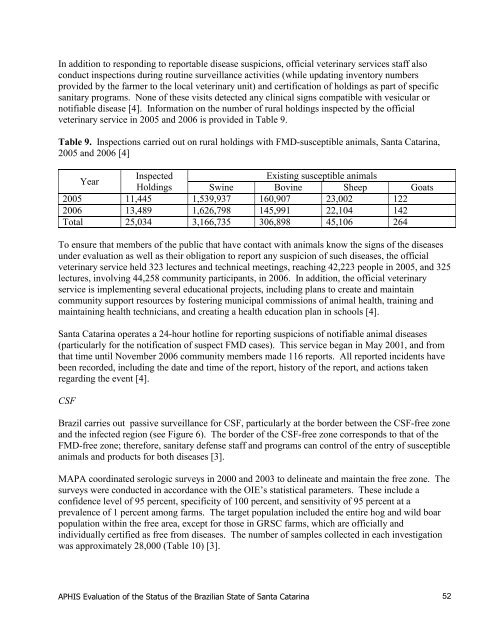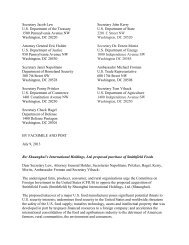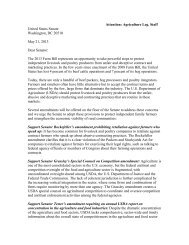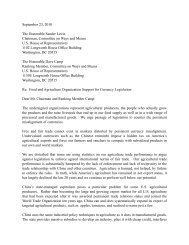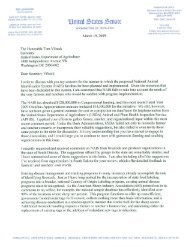Exhibit 8, 100416 Brazil FMD Risk Evaluation - R-Calf
Exhibit 8, 100416 Brazil FMD Risk Evaluation - R-Calf
Exhibit 8, 100416 Brazil FMD Risk Evaluation - R-Calf
You also want an ePaper? Increase the reach of your titles
YUMPU automatically turns print PDFs into web optimized ePapers that Google loves.
In addition to responding to reportable disease suspicions, official veterinary services staff also<br />
conduct inspections during routine surveillance activities (while updating inventory numbers<br />
provided by the farmer to the local veterinary unit) and certification of holdings as part of specific<br />
sanitary programs. None of these visits detected any clinical signs compatible with vesicular or<br />
notifiable disease [4]. Information on the number of rural holdings inspected by the official<br />
veterinary service in 2005 and 2006 is provided in Table 9.<br />
Table 9. Inspections carried out on rural holdings with <strong>FMD</strong>-susceptible animals, Santa Catarina,<br />
2005 and 2006 [4]<br />
Year<br />
Inspected<br />
Existing susceptible animals<br />
Holdings Swine Bovine Sheep Goats<br />
2005 11,445 1,539,937 160,907 23,002 122<br />
2006 13,489 1,626,798 145,991 22,104 142<br />
Total 25,034 3,166,735 306,898 45,106 264<br />
To ensure that members of the public that have contact with animals know the signs of the diseases<br />
under evaluation as well as their obligation to report any suspicion of such diseases, the official<br />
veterinary service held 323 lectures and technical meetings, reaching 42,223 people in 2005, and 325<br />
lectures, involving 44,258 community participants, in 2006. In addition, the official veterinary<br />
service is implementing several educational projects, including plans to create and maintain<br />
community support resources by fostering municipal commissions of animal health, training and<br />
maintaining health technicians, and creating a health education plan in schools [4].<br />
Santa Catarina operates a 24-hour hotline for reporting suspicions of notifiable animal diseases<br />
(particularly for the notification of suspect <strong>FMD</strong> cases). This service began in May 2001, and from<br />
that time until November 2006 community members made 116 reports. All reported incidents have<br />
been recorded, including the date and time of the report, history of the report, and actions taken<br />
regarding the event [4].<br />
CSF<br />
<strong>Brazil</strong> carries out passive surveillance for CSF, particularly at the border between the CSF-free zone<br />
and the infected region (see Figure 6). The border of the CSF-free zone corresponds to that of the<br />
<strong>FMD</strong>-free zone; therefore, sanitary defense staff and programs can control of the entry of susceptible<br />
animals and products for both diseases [3].<br />
MAPA coordinated serologic surveys in 2000 and 2003 to delineate and maintain the free zone. The<br />
surveys were conducted in accordance with the OIE’s statistical parameters. These include a<br />
confidence level of 95 percent, specificity of 100 percent, and sensitivity of 95 percent at a<br />
prevalence of 1 percent among farms. The target population included the entire hog and wild boar<br />
population within the free area, except for those in GRSC farms, which are officially and<br />
individually certified as free from diseases. The number of samples collected in each investigation<br />
was approximately 28,000 (Table 10) [3].<br />
APHIS <strong>Evaluation</strong> of the Status of the <strong>Brazil</strong>ian State of Santa Catarina 52


